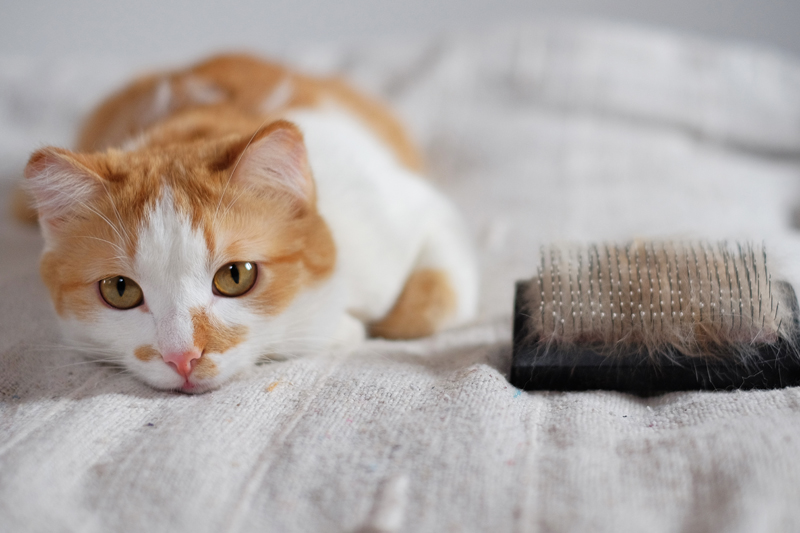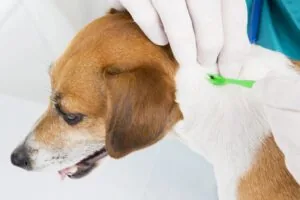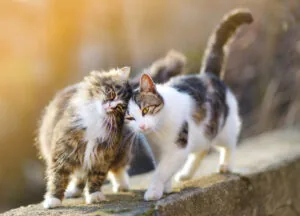Feline Hairballs

Cats are consummate groomers that work hard to keep their coats shiny and immaculate. While cleaning themselves with their tongues, felines ingest fur that has been shed. This fur cannot be broken down or digested and if it doesn’t pass through a cat’s digestive tract, it can form into hairballs. Most cat owners have dealt with hairballs in cats at one time or another. Vomiting an occasional hairball is normal for most cats. However, if the vomiting is persistent, is frequent or appears to be painful, it may indicate a more serious health issue.
What are Hairballs?
Hairballs are balled tufts of hair that form in your cat’s digestive tract after grooming sessions. Feline tongues have hook-like features that trap loose, previously shed hair. When your cat swallows the fur, it travels to its stomach and is not digested. Most fur harmlessly leaves a cat’s digestive tract without causing problems. Other times, a pet will vomit the trapped hair that isn’t excreted through stools. And, despite its name, the hairball isn’t always in a round shape; it will usually have an elongated shape after it passes through your cat’s esophagus.
Which Cats Are More Likely to Develop Hairballs?
All cats develop hairballs at some point in their lives. Long-haired cats, such as Persians and Maine Coons, are more susceptible to hairballs simply because they have more hair than their short-haired friends. Hairballs may be more common when the weather warms, too, as all cats tend to shed their heavier winter coats. Additionally, felines that constantly groom will be more prone to hairballs. Older cats also regurgitate more hairballs. The reason is that as a cat ages, it becomes a better groomer and, therefore, more reason to develop them.
Signs and Symptoms
A feline’s gut is designed to process fur, its own as well as the fur attached to prey animals, and as such we should not really see repeated hairballs in a healthy cat. If you have noticed your cat bringing up hairballs or coughing like they are going to, then a trip to the vet is sensible.
The most common signs observed by owners include:
● Retching/gagging
● Vomiting – food and/or mucus and/or hairballs
● Reduced appetite
● Constipation
● Weight Loss
● Changes in Bowel Movements
● Distended Belly
If your cat shows any of these signs repeatedly for more than 24 hours please see your veterinarian. In the severest of situations a hairball can cause a blockage of the intestine. Symptoms may then include repeated vomiting, abdominal pain and discomfort and will require urgent veterinary attention.
Diagnosis of Hairballs in Cats
Diagnosing hairballs in cats starts with seeing the hairball itself. Occasional cat hairballs are normal for most cats and may not require additional diagnostics. However, if cat hairballs are seen frequently, or if vomiting or coughing occurs without the presence of hairballs, additional diagnostics may be necessary. Routine blood screens that consist of a complete blood cell count, a blood chemistry profile and perhaps a thyroid screening test may be recommended.
A urinalysis may be collected to further evaluate kidney and lower urinary tract function. Fecal examinations are normally also performed to check for intestinal parasites. Depending on the results of these tests, other diagnostic tests may be recommended. Abdominal radiographs (X-rays) and/or an abdominal ultrasound may be advisable for a cat who vomits or has frequent or difficult hairballs. This is done to evaluate the health of the stomach, including whether it is able to empty, as well as the health of the intestinal tract. In some unique cases, an endoscopic examination of the esophagus or intestinal tract may be in order.
Treatment and Prevention
The treatment and prevention of hairballs is generally focused on the following:
● Laxatives and other medications – these help lubricate and move the hairball through the intestine
● Hairball control foods and treats – these have added fiber to help bind the hair and stimulate the intestine to aid in eliminating hairballs.
● Additional brushing of the coat with specially designed brushes to remove as much loose hair as possible, subsequently reducing the volume of hair ingested.
More recently the focus has shifted, and it is now recognized that hairballs are a symptom rather than a problem in their own right. The aim is to identify any underlying cause with either the gastrointestinal tract or the skin and treat accordingly to improve outcomes.
In summary, recurrent hairballs should not be seen as normal in an otherwise healthy cat. It may indicate that there is an underlying problem that needs to be assessed and treated by your veterinarian. Please call to make an appointment if you have noticed your cat has had hairballs or you are unsure why they have been vomiting.
Share This Post
Recent Posts
About Shallowford Animal Hospital
Shallowford Animal Hospital and The Pet Spa at Shallowford are dedicated to the exceptional, compassionate care your pet deserves. Pets hold a very special place in our families, and we treat yours like our own.



